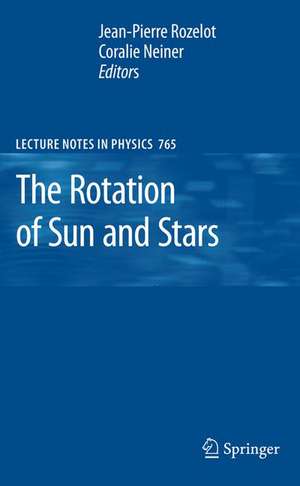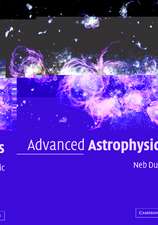The Rotation of Sun and Stars: Lecture Notes in Physics, cartea 765
Editat de Jean-Pierre Rozeloten Limba Engleză Hardback – 8 ian 2009
| Toate formatele și edițiile | Preț | Express |
|---|---|---|
| Paperback (1) | 386.99 lei 6-8 săpt. | |
| Springer Berlin, Heidelberg – 22 oct 2010 | 386.99 lei 6-8 săpt. | |
| Hardback (1) | 392.60 lei 6-8 săpt. | |
| Springer Berlin, Heidelberg – 8 ian 2009 | 392.60 lei 6-8 săpt. |
Din seria Lecture Notes in Physics
- 19%
 Preț: 423.99 lei
Preț: 423.99 lei - 17%
 Preț: 360.73 lei
Preț: 360.73 lei -
 Preț: 429.22 lei
Preț: 429.22 lei - 17%
 Preț: 427.62 lei
Preț: 427.62 lei - 17%
 Preț: 460.25 lei
Preț: 460.25 lei -
 Preț: 427.96 lei
Preț: 427.96 lei -
 Preț: 481.93 lei
Preț: 481.93 lei - 17%
 Preț: 494.64 lei
Preț: 494.64 lei -
 Preț: 281.90 lei
Preț: 281.90 lei - 17%
 Preț: 493.20 lei
Preț: 493.20 lei - 17%
 Preț: 426.72 lei
Preț: 426.72 lei -
 Preț: 365.15 lei
Preț: 365.15 lei -
 Preț: 374.52 lei
Preț: 374.52 lei -
 Preț: 407.98 lei
Preț: 407.98 lei - 20%
 Preț: 428.12 lei
Preț: 428.12 lei -
 Preț: 263.30 lei
Preț: 263.30 lei - 15%
 Preț: 593.73 lei
Preț: 593.73 lei - 15%
 Preț: 528.13 lei
Preț: 528.13 lei -
 Preț: 493.12 lei
Preț: 493.12 lei - 17%
 Preț: 425.68 lei
Preț: 425.68 lei -
 Preț: 280.65 lei
Preț: 280.65 lei -
 Preț: 163.41 lei
Preț: 163.41 lei - 18%
 Preț: 726.59 lei
Preț: 726.59 lei -
 Preț: 394.84 lei
Preț: 394.84 lei - 15%
 Preț: 709.63 lei
Preț: 709.63 lei - 15%
 Preț: 623.90 lei
Preț: 623.90 lei - 20%
 Preț: 476.91 lei
Preț: 476.91 lei - 15%
 Preț: 428.05 lei
Preț: 428.05 lei -
 Preț: 342.78 lei
Preț: 342.78 lei - 18%
 Preț: 851.93 lei
Preț: 851.93 lei -
 Preț: 346.61 lei
Preț: 346.61 lei -
 Preț: 391.57 lei
Preț: 391.57 lei - 15%
 Preț: 633.16 lei
Preț: 633.16 lei -
 Preț: 451.71 lei
Preț: 451.71 lei - 5%
 Preț: 1497.80 lei
Preț: 1497.80 lei -
 Preț: 374.85 lei
Preț: 374.85 lei -
 Preț: 380.07 lei
Preț: 380.07 lei - 15%
 Preț: 516.14 lei
Preț: 516.14 lei - 15%
 Preț: 583.78 lei
Preț: 583.78 lei - 15%
 Preț: 508.60 lei
Preț: 508.60 lei -
 Preț: 469.71 lei
Preț: 469.71 lei -
 Preț: 388.90 lei
Preț: 388.90 lei - 15%
 Preț: 500.24 lei
Preț: 500.24 lei -
 Preț: 386.52 lei
Preț: 386.52 lei - 15%
 Preț: 472.88 lei
Preț: 472.88 lei -
 Preț: 424.27 lei
Preț: 424.27 lei -
 Preț: 380.07 lei
Preț: 380.07 lei - 15%
 Preț: 500.01 lei
Preț: 500.01 lei
Preț: 392.60 lei
Nou
Puncte Express: 589
Preț estimativ în valută:
75.13€ • 77.99$ • 62.65£
75.13€ • 77.99$ • 62.65£
Carte tipărită la comandă
Livrare economică 24 martie-07 aprilie
Preluare comenzi: 021 569.72.76
Specificații
ISBN-13: 9783540878308
ISBN-10: 3540878300
Pagini: 270
Ilustrații: X, 264 p. 118 illus., 28 illus. in color.
Dimensiuni: 155 x 235 x 15 mm
Greutate: 0.52 kg
Ediția:2009
Editura: Springer Berlin, Heidelberg
Colecția Springer
Seria Lecture Notes in Physics
Locul publicării:Berlin, Heidelberg, Germany
ISBN-10: 3540878300
Pagini: 270
Ilustrații: X, 264 p. 118 illus., 28 illus. in color.
Dimensiuni: 155 x 235 x 15 mm
Greutate: 0.52 kg
Ediția:2009
Editura: Springer Berlin, Heidelberg
Colecția Springer
Seria Lecture Notes in Physics
Locul publicării:Berlin, Heidelberg, Germany
Public țintă
ResearchCuprins
The Sun: A Slowly Rotating Star.- What Is Coming: Issues Raised from Observation of the Shape of the Sun.- Effects of Rotation on Stellar p-Mode Frequencies.- Approaching the Low-Frequency Spectrum of Rotating Stars.- The Rotation of the Solar Core.- Physics of Rotation in Stellar Models.- Long Baseline Interferometry of Rotating Stars Across the HR Diagram: Flattening, Gravity Darkening, Differential Rotation.- Is the Critical Rotation of Be Stars Really Critical for the Be Phenomenon?.- On the Rotation of A-Type Stars.- The Solar Magnetic Field: Surface and Upper Layers, Network and Internetwork Field.
Textul de pe ultima copertă
The Sun and stars rotate in different ways and at different rates of velocity, and knowledge of how they rotate is important in understanding the formation and evolution of stars and their structure.
The wide variety of stars offers an equally wide variety of rotation rates and rotational evolution. From the slowly rotating stars to stars rotating close to their breakup velocities, different techniques and models have to be developed to study rotation and its effects on physical aspects of stars. In fact, one currently witnesses a complete renewal of astrophysical ideas about stellar rotation, mainly due to the development of new models including high-order effects of rotation and magnetism.
This book, while not attempting to answer all questions about rotation, given that many issues still have to be further investigated, focuses on the basics and some particular aspects while aiming to show why it is important, from a physical point of view, to study stellar rotation.
Based on courses given at a graduate school, these tutorial lectures will be of interest and useful to a rather broad audience of scientists and students.
The wide variety of stars offers an equally wide variety of rotation rates and rotational evolution. From the slowly rotating stars to stars rotating close to their breakup velocities, different techniques and models have to be developed to study rotation and its effects on physical aspects of stars. In fact, one currently witnesses a complete renewal of astrophysical ideas about stellar rotation, mainly due to the development of new models including high-order effects of rotation and magnetism.
This book, while not attempting to answer all questions about rotation, given that many issues still have to be further investigated, focuses on the basics and some particular aspects while aiming to show why it is important, from a physical point of view, to study stellar rotation.
Based on courses given at a graduate school, these tutorial lectures will be of interest and useful to a rather broad audience of scientists and students.
Caracteristici
Includes supplementary material: sn.pub/extras












